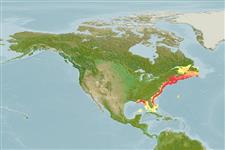Teleostei (teleosts) >
Gadiformes (Cods) >
Phycidae (Phycid hakes)
Etymology: Urophycis: Greek, oura = tail + Greek, phyke, pykis, -idos = the female of a fish that lives among algae (Greek = phykon), related with the gudgeon (Ref. 45335).
More on author: Walbaum.
Issue
Urophycis=feminine Ref. 1830
Environment: milieu / climate zone / depth range / distribution range
Ecology
Marine; demersal; non-migratory; depth range 0 - 494 m (Ref. 57178), usually 110 - 185 m (Ref. 1371). Subtropical; 52°N - 23°N, 90°W - 53°W (Ref. 56857)
Northwest Atlantic: Canada to southern New England to the northeast coast of Florida; also found in the northeastern Gulf of Mexico.
Size / Weight / Age
Maturity: Lm ? range ? - ? cm
Max length : 43.0 cm TL male/unsexed; (Ref. 49746); common length : 17.0 cm TL male/unsexed; (Ref. 1371)
Dorsal spines (total): 0; Anal spines: 0. Upper limb of the first gill arch with 2 or 3 rakers. Head with a series of dark spots; opercle with a dusky blotch. First dorsal fin with a dark blotch and a distinct white margin.
Found onshore, most common between 110 and 185 m. Feed on crustaceans, and possibly fish and squids. Juveniles spend part of their time in estuaries.
Life cycle and mating behavior
Maturities | Reproduction | Spawnings | Egg(s) | Fecundities | Larvae
Cohen, D.M., T. Inada, T. Iwamoto and N. Scialabba, 1990. FAO species catalogue. Vol. 10. Gadiform fishes of the world (Order Gadiformes). An annotated and illustrated catalogue of cods, hakes, grenadiers and other gadiform fishes known to date. FAO Fish. Synop. 125(10). Rome: FAO. 442 p. (Ref. 1371)
IUCN Red List Status (Ref. 130435)
Threat to humans
Harmless
Human uses
Fisheries: minor commercial
Tools
Special reports
Download XML
Internet sources
Estimates based on models
Preferred temperature (Ref.
123201): 5.2 - 22.6, mean 7.6 °C (based on 46 cells).
Phylogenetic diversity index (Ref.
82804): PD
50 = 0.5044 [Uniqueness, from 0.5 = low to 2.0 = high].
Bayesian length-weight: a=0.00490 (0.00406 - 0.00590), b=3.14 (3.09 - 3.19), in cm total length, based on LWR estimates for this species (Ref.
93245).
Trophic level (Ref.
69278): 4.4 ±0.0 se; based on diet studies.
Resilience (Ref.
120179): Medium, minimum population doubling time 1.4 - 4.4 years (Preliminary K or Fecundity.).
Fishing Vulnerability (Ref.
59153): Low to moderate vulnerability (33 of 100).
Nutrients (Ref.
124155): Calcium = 69.2 [29.4, 153.8] mg/100g; Iron = 1.01 [0.55, 1.87] mg/100g; Protein = 18.6 [17.3, 20.0] %; Omega3 = 0.425 [0.220, 0.814] g/100g; Selenium = 34.2 [16.9, 71.4] μg/100g; VitaminA = 14.9 [4.4, 50.8] μg/100g; Zinc = 0.609 [0.413, 0.904] mg/100g (wet weight);
